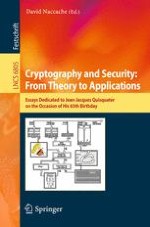This Festschrift volume, published in honor of Jean-Jaques Quisquater on the occasion of his 65th Birthday, contains 33 papers from colleagues all over the world and deals with all the fields to which Jean-Jaques dedicated his work during his academic career. Focusing on personal tributes and re-visits of Jean-Jaques Quisquater's legacy, the volume addresses the following central topics: symmetric and asymmetric cryptography, side-channels attacks, hardware and implementations, smart cards, and information security. In addition there are four more contributions just "as diverse as Jean-Jacques' scientific interests".
